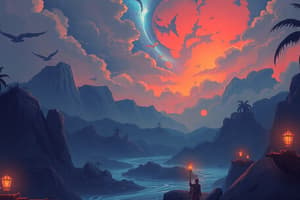Podcast
Questions and Answers
How do you define the 'boom'?
How do you define the 'boom'?
Literary phenomenon that reached its peak in the 1960s and continued to the 70s.
What did the literary boom include?
What did the literary boom include?
Included highly experimental qualities, used new literary devices.
What are some examples of new literary devices included in boom literature?
What are some examples of new literary devices included in boom literature?
A Latin American cultural adaptation of universal metaphors and imagery; the use of polyphonic narration; use of non-linear narratives and cyclical repetition.
How did 'Boom' authors go about the change?
How did 'Boom' authors go about the change?
What were the benefits of the boom?
What were the benefits of the boom?
Why did the world of literature focus so intensely on the 'Boom' in particular?
Why did the world of literature focus so intensely on the 'Boom' in particular?
What are some examples of political turmoil and what did it do for the movement?
What are some examples of political turmoil and what did it do for the movement?
Who were the 4 big names of Boom literature, where were they from and why are they 'big names'?
Who were the 4 big names of Boom literature, where were they from and why are they 'big names'?
What is García Márquez accredited with?
What is García Márquez accredited with?
How does magical realism relate to Latin America?
How does magical realism relate to Latin America?
What is Mario Vargas Llosa known for?
What is Mario Vargas Llosa known for?
What was the epitome of historical fiction?
What was the epitome of historical fiction?
What was published in 1969 and who by?
What was published in 1969 and who by?
Which novel is known as a key work of the boom movement?
Which novel is known as a key work of the boom movement?
Flashcards are hidden until you start studying
Study Notes
El Boom Literario Overview
- The "Boom" is a literary phenomenon that peaked in the 1960s and continued into the 1970s.
- It featured a shift towards highly experimental literature, incorporating new literary devices.
Key Literary Devices
- Latin American writers adapted universal metaphors and imagery, creating a rich cultural narrative.
- Polyphonic narration emerged, utilizing multiple narrators to enhance storytelling.
- Non-linear narratives and cyclical repetition became prevalent, allowing for intricate plot structures.
Influence of Previous Literary Movements
- Boom authors drew inspiration from American realist literature, employing established imagery, dialogue, and settings.
Impact on Literature and National Borders
- The Boom transcended national boundaries, uniting writers from diverse backgrounds and nationalities.
Historical Context
- The focus on the Boom was fueled by significant mid-twentieth century events in Latin America, placing the region prominently in global affairs.
- Authoritarian military regimes, such as Castro’s in 1959, shaped the political landscape and influenced literary themes.
Prominent Authors
- Key figures of the Boom include Carlos Fuentes (Mexico), Mario Vargas Llosa (Peru), Gabriel García Márquez (Colombia), and Julio Cortázar (Argentina), known for producing internationally acclaimed novels.
Notable Contributions
- Gabriel García Márquez is credited with inventing "magical realism," a genre where the boundary between magic and reality is often blurred.
- Mario Vargas Llosa is recognized for his work in historical fiction, particularly the "dictator novel" (caudillo) as a significant subgenre.
Significant Publications
- In 1969, Carlos Fuentes published "La nueva novela hispanoamericana," a literary essay praising the originality of Latin American literature.
- "La muerte de Artemio Cruz" is recognized as a key work of the Boom, presenting an experimental biography of the protagonist on his deathbed.
Studying That Suits You
Use AI to generate personalized quizzes and flashcards to suit your learning preferences.




